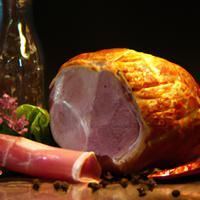
1 serving (100 grams) contains 250 calories, 18.0 grams of protein, 20.0 grams of fat, and 0.0 grams of carbohydrates.

Log this food in SnapCalorie

Nutrition Information
Calories |
595.2 | ||
|---|---|---|---|
% Daily Value* |
|||
| Total Fat | 47.6 g | 61% | |
| Saturated Fat | 16.7 g | 83% | |
| Polyunsaturated Fat | 0 g | ||
| Cholesterol | 166.7 mg | 55% | |
| Sodium | 1904.8 mg | 82% | |
| Total Carbohydrates | 0 g | 0% | |
| Dietary Fiber | 0 g | 0% | |
| Sugars | 0 g | ||
| protein | 42.9 g | 85% | |
| Vitamin D | 0 mcg | 0% | |
| Calcium | 23.8 mg | 1% | |
| Iron | 2.4 mg | 13% | |
| Potassium | 714.3 mg | 15% | |
* Percent Daily Values are based on a 2,000 calorie diet. Your daily values may be higher or lower depending on your calorie needs.
Food Attributes
Source of Calories
About Hinternschinken
Hinternschinken is a German cured ham, typically sourced from the hind leg of the pig. Known for its rich, smoky flavor and tender texture, it is often enjoyed thinly sliced as part of charcuterie boards, sandwiches, or traditional dishes. This delicacy is crafted through a meticulous curing process, involving salt and sometimes a blend of spices, followed by slow smoking. Hinternschinken is high in protein, making it a satisfying option for those seeking muscle repair and energy. However, it can be high in sodium and saturated fat due to the curing process. Moderation is key when including it in a balanced diet. Originating in Germanic cuisine, Hinternschinken represents a cornerstone of European meat preservation traditions, offering both a cultural experience and culinary versatility. Its robust flavor pairs well with hearty breads, cheeses, and seasonal vegetables, making it a flavorful addition to meals.



